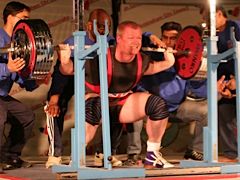 Getting ready for your first powerlifting meet? The Shaac's Dickie White shares a few things that may just help out.
Getting ready for your first powerlifting meet? The Shaac's Dickie White shares a few things that may just help out.
Results matching “Bird”
 Check out the latest offering from the Diesel Crew - the Spray Series. What is it?
Check out the latest offering from the Diesel Crew - the Spray Series. What is it?
It is an online community for coaches and athletes of all ages and levels to come and find information and advice on all aspects of Speed, Strength, and Conditioning. With some of the top strength coaches from across the country contributing valuable training insight it is our desire that the Spray Series become one of the leading resources for the sharing of knowledge and ideas for the benefit of your athletes and training programs so that they may be taken to new levels.- Jason Spray MS, CSCS, SCCC, USAW
Ask Team Spray a question about strength and conditioning for football, basketball or any other sport - and get your question answered on the site. For a taste of just what's on offer, swing by the Youtube channel. There's some intense strength-training footage on there.
Team Spray
This is a top-quality team, comprising :
Jason serves as the director of Strength and Conditioning at Middle Tennessee State University for the Men’s basketball program.
E.J. is the Assistant Strength and Conditioning Coach for the Middle Tennessee State Blue Raiders Men’s Basketball and Football teams.
Drew is a Certified Athletic Trainer responsible for Middle Tennessee State University’s Men’s basketball team.
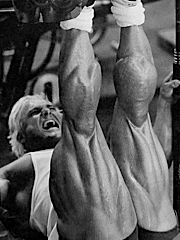 It's been an exceptionally busy week here. The following made an appearance amid the mayhem :
It's been an exceptionally busy week here. The following made an appearance amid the mayhem :
- Articles : Jedd introduced the joys of training with a replica Inch Dumbbell, John Kaiser looked at the power of One Set Wonders and I had a fascinating chat with Personal Trainer Jason Kirby.
- Videos : This is what to do when you can't find an 1,100 lb tire to flip, the trailer for 20 Seconds of Joy peers into the mind of a BASE Jumper and - for your viewing pleasure - here's the Roller Suit. 60mph without a car.
- Sites : Fight Geek keeps a close eye on the world of combat athletics, Ace shares his passions for cooking, basketball and triathlons and I noted a few of my favourite strength-training forums. Any others I should check out?
- Ideas : Put your grip to the test with the Towel RDL, learn a few new kettlebell moves with this superb collection of demonstration videos and try some of these. Good stuff.
- Bonus : I've been a fan of Ironmind gear for several years now, and I find myself swinging by their site on a fairly regular basis.
If you're the same, you'll love this. Although there's no RSS feed on the Ironmind site itself, Petr Ruzicka's just created one over at Feed43. To see what Ironmind's up to from the comfort of your feed reader, head over to :
Thanks Petr. Much appreciated.
 Fitness model Monica Starr.
Fitness model Monica Starr.
 Via Physical Strategies : Tom points to a nice article - Cables to Enable, by John McKean - over on the Strandpulling forum. Enjoy.
Via Physical Strategies : Tom points to a nice article - Cables to Enable, by John McKean - over on the Strandpulling forum. Enjoy.
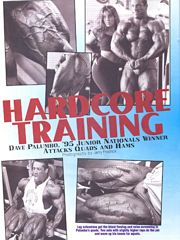 Hey you! Are you the kind of guy or gal with limited time and limited energy? You are. Good, because I am writing this post just for you! I want to encourage you that you don’t need to be ashamed to stop an exercise after just one set. You can achieve great results with one set training.* Great results that don’t require you to spend 45 minutes to an hour in the gym! Results that won’t leave you burned out after only two months of training. Sound good to you? Then read on.
Hey you! Are you the kind of guy or gal with limited time and limited energy? You are. Good, because I am writing this post just for you! I want to encourage you that you don’t need to be ashamed to stop an exercise after just one set. You can achieve great results with one set training.* Great results that don’t require you to spend 45 minutes to an hour in the gym! Results that won’t leave you burned out after only two months of training. Sound good to you? Then read on.
Let us begin by considering the case of Trainer A and his client Anonymous Guy. For the last four months I’ve seen Anonymous Guy settle down on the bench press and spend seven to ten minutes performing six sets—three sets building up to a max weight and three descending sets. Funny thing I noticed though, he has been bench pressing almost the EXACT same weight for about four months. Why would you pay a trainer who can’t get you results? Why would you engage in a long process of multiple sets when it eats up your time while you reap little to no added reward for your extra efforts?
With my usual condescension I guessed his failures were due to his multiple set routine. But it wasn’t just my huge ego that led me to that conclusion. I once was a multiple set guy, and I suffered heavily for it. It all started soon after my thirteenth birthday. I read Arnold’s book, Bodybuilding for Men. From there I picked up copies of Flex Magazine, Ironman, and all the usual suspects. I learned that all bodybuilders use(d) multiple sets: double-sets, triple-sets, and sometimes even octuple sets. As a highly impressionable young man who wanted to add bulk to his scrawny frame, naturally enough I copied them. I would try any kind of multiple set programs I could get my hands on: ascending sets, descending sets, ascending and then descending sets, etc. There was even a point where I tried octuple sets based on the advice of a certain bodybuilder that Ironman magazine covered back in the 90s. I mimicked the workouts I saw in the magazines never realizing that a human being who isn’t filled with anabolic steroids and growth hormone shouldn’t engage in such behavior. I didn’t know that multiple sets would lead me to over-train countless times, drain me of my love of weight lifting, leave me psychologically numb toward intense activity in general, and culminate in an on-again-off-again relationship with weight lifting that would see me spend more time in lazy indulgence than intense bouts of heavy lifting.
Well, it was about a month into my most recent return to resistance training (March, 2007) that I felt tired, drained, and numb all over. I was at a point where I could have easily backed out and quit—again. But instead I took a step back and decided to shuffle my program around. I dropped multiple sets, and decided to do only one set of each exercise. I decided to take the radical step of limiting both the number of sets I performed and the number of exercises. But my first time in the gym after my resolution, after I finished my first single set exercise—a bench press—I felt something. It was a powerful tug, a kind of guilt, like everyone in the gym was looking at me as if I was some kind of wimp. Why not perform a second set—or even a third or fourth?
I admit I gave in. It was only after I finished my workout that I felt guilty and realized that I had an addiction to multiple sets. A strong combination of shame, guilt, pride, and ego wouldn’t let me leave them behind.
Faced with my addiction, I decided to do one of my patented, copyrighted, and trademarked “Two Week Total Transformation Tests”—a two week period when I will try about anything to see whether it is helpful, harmful, or meaningless. I decided to cut the extra sets from my workouts for two weeks. After all, two weeks isn’t that long, but it is usually long enough to see some difference. I threw myself into my workouts over the next two weeks. Although I didn’t use multiple sets, I did use negatives when I failed to finish a set. And I performed all sets to failure, no exceptions, and usually about 6-8 reps per exercise.
At first I still felt like I needed to perform more sets. But I held out and persevered. One thing I noticed immediately was that while I felt “the burn” on the day of my workout, I no longer felt burned out and sore the day after my workout. My workouts were intense and my time in the gym was hell, but soon after I left the gym I could leave that pain behind and get on with my life. My body was recovering with greater celerity than before and that felt good. More importantly, I made significant strength gains—better than I had before with multiple sets. I wasn’t hitting plateaus as much this time around as I had in the past. Furthermore, I was losing weight and gaining mass. I watched my waist measurement shrink while my arms grew and my chest and shoulders widened.
To think, I had been sabotaging my workouts for so long and I had never realized it.
The Challenge
Instead of engaging in some long winded diatribe where I quote lots of statistics, how about we keep this simple. Take a chance for two weeks and try a single set routine out and see how you feel. Get the most bang for your buck by combining a single set routine with a workout almost exclusively composed of multi-joint exercises. Here is a sample workout—actually it is my workout for tomorrow. You can throw in one set of bicep curls if you absolutely must. Try 6-8 reps to failure of the following movements:
Squats, Chin-ups, Deadlift, Clean & Press, Shoulder Press, Bench Press, Weighted Sit-ups, Pull-downs
If it doesn’t work for you, then worst case scenario, you just gave your body a well deserved two week break from multiple sets. But I am confident that many of you will achieve the same gains and benefits I have. I look forward to hearing/reading your success stories!
- A slight majority of studies (7 out of 13) show that there is some added benefit to multiple sets if you are training for increased strength. I haven’t seen any work on the advantages of single or multiple set routines on muscle growth, recovery, and muscular endurance. If you have info/studies/anecdotes, don't be shy about posting it in the comments section.
 Bodybuilder Stacy Garonzik.
Bodybuilder Stacy Garonzik.
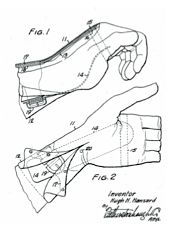 Via Powerlifting Watch : Brazilian powerlifter Marília Coutinho takes an extremely comprehensive look at the history of the humble Wrist Wrap [272kb, .pdf], and its role in Powerlifting. A great read.
Via Powerlifting Watch : Brazilian powerlifter Marília Coutinho takes an extremely comprehensive look at the history of the humble Wrist Wrap [272kb, .pdf], and its role in Powerlifting. A great read.
 This is a guest post by Todd Goldfarb of We The Change. A great site.
This is a guest post by Todd Goldfarb of We The Change. A great site.
'Physical activity' is usually regarded as the pursuit of exercising the muscles, tendons and joints of the body, and rarely thought of as benefiting our internal organs (outside of the heart). But this is a limited viewpoint as effective fitness can have a profound impact all of our vital organs, especially the brain.
Researchers now believe that we can work-out our brains by adopting many of the same habits that sustain a healthy body, from focusing on good nutrition and physical fitness to managing stress.
This is important for us because the well-maintained brain is quicker, smarter, less forgetful, and less prone to age-related decline. Here are several ways to treat the brain real good:
Food Choices
Roughly 50-60% of the brain's overall weight is pure fat (the rest of it is a mix of protein and carbohydrates). The brain uses fat as insulation for its billions of nerve cells. The better insulated a cell, the faster it sends messages and the speedier your thinking.
For this reason, fats are excellent food for the brain. But, all fats are not created equal, and it is necessary to educate yourself on which fats will serve the functionality of the brain best. As a general rule, any source of omega-3 fats such as walnuts, flaxseed, flaxseed oil or dark, leafy green vegetables will help the brain run smoothly.
However, FISH provides the brain with its favorite form of fat: DHA (docosahexaenoic acid). According to David Perlmutter, co author of The Better Brain Book, "DHA is far and away the most important nutrient for brain health". Salmon and Anchovies are excellent sources of DHA.
Relaxation
Chronic stress takes a heavy toll on the brain because stress hormones (such as corticosteroids) contribute to a general environment of inflammation and attack the brain's memory center, the hippocampus.
According to researchers, stress is most damaging when you let it eat away at you. Therefore, it is extremely beneficial to find a way to do something about it. Deep breathing is an excellent way to relax, as is the practice of meditation which has long been known to alter brain waves.
In fact, recent studies have shown that meditation can change the physical structure of the brain (in a positive way). Therefore, our thoughts DO play a major role when it comes to the health of our brain.
Antioxidants
The brain produces more free radicals- highly reactive cells that contribute to cell damage- than any other organ. Antioxidants are the body's clean-up crew, and work around the clock to scrub the body clean of free radicals.
They are found primarily in fruits and vegetables, and are in great abundance in berries (especially blueberries and Goji berries).
Exercise
Working up a sweat is critical for brain health. "Across the board, exercise increases brain function, memory retention and other key areas of cognition up to 20 percent" says Arthur D. Kramer, PhD, neuroscientist at the University of Illinois.
The brain accounts for only 2% of the body's weight, but accounts for 15% of its blood flow, and regular exercise keeps the brain's arteries open and unclogged. New research is suggesting that exercise may actually encourage the brain to make new connections between neurons and build new vascular structures.
Bottom line, get on that treadmill and lift some weights-it's good for your brain!
Refined Sugars
The brain needs sugar (glucose) for energy. However, it prefers a nice steady and natural supply of it- the kind you find in fruits and vegetables- not in the refined sugars heaped in energy drinks and candy.
High sugar foods send a tidal wave of glucose crashing into the bloodstream, overwhelming the body's ability to store balance. Habitual ingestion of simple carbs and processed foods causes chronic inflammation, type-2 diabetes, and host of other health problems.
Needless to say, none of this is good for the brain and it is great practice to limit your intake of refined sugars.
Purposefully flexing the brain muscle through physical activity, proper nutrition, and deep relaxation is a great way to live a longer and healthier life!
This article originally appeared on We The Change. For many more articles like this, swing by the site. You won't be disappointed.
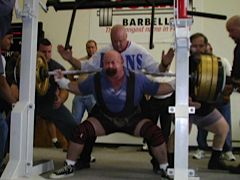 Via Rif's Blog : A good piece by the one-and-only Louie Simmons. Things you should know [124kb, .pdf].
Via Rif's Blog : A good piece by the one-and-only Louie Simmons. Things you should know [124kb, .pdf].
